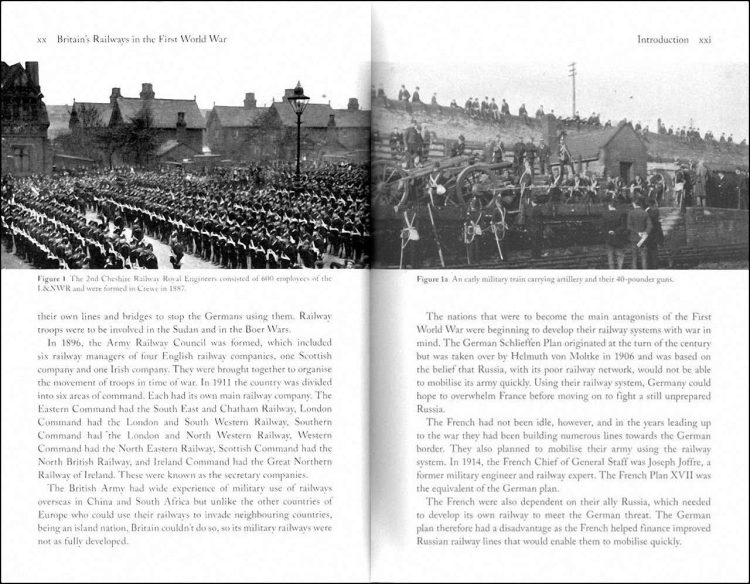Written by Michael Foley and published by Pen & Sword, this hardback book measures around 23.5 cm x 16.1 cm, is 232 pages long, and has 116 black and white illustrations.
It has a published price of £20.00, but at the time of writing Pen & Sword is offering it for an online discount of 10% and it can be purchased from Amazon from £15.90.
The book is very similar to “Britain's Railways in the Second World War” by the same author which was published in November 2020. It tells of the way railway companies transported troops and materials during wartime, turned their workshops over to war work, and suffered staff shortages as so many men were called up or volunteered for service, and so played a vital role in supporting the war effort.
With an Introduction, six chapters and two appendices, wartime events are described in chronological order. Each chapter is dedicated to a particular year from 1914 to 1919 and is in an easy format for casual reading.
Many interesting photographs give a great flavour of the railway stock and its state throughout the war period. The selection is well balanced and covers a wide range of places, types, and conditions.
Part of the 1919 chapter seems to be outside the scope of the book, as it also provides an overview of events after the war including a railway strike in 1920, rejection of nationalisation in 1921, and the 1923 Grouping. Similarly, Appendix 1 lists the constituent companies that formed the Big Four in 1923 and is also outside the scope of this book.
There are some errors that should have been picked up during proof reading. One such is in the Introduction, where the author states that at the turn of the century the country was divided into six geographic military areas by the War Railway Council. The Council also appointed Secretary Railway Companies which would act on behalf of all the railway companies operating within their command. However, the author states that Southern Command had the London & North Western Railway under its command and Western Command had the North Eastern Railway, which just doesn't make sense. The list of commands and secretary companies are repeated in Chapter One, but this time it's correct with Southern Command having the London & South Western Railway under its command and Western Command having the London & North Western Railway.
The size of the book precludes a detailed investigation of the link between our railways and the First World War, but it does give a reasonably in-depth description of the contribution that our railways made to the final victory.
It seems strange now that a regiment could be formed solely from railway employees, but that is what we see on the left below with the 2nd Cheshire Railway Royal Engineers. Even more remarkable is that it was formed in 1887 and comprised 600 employees of the London & North Western Railway. Attracting a lot of attention is the train on the right carrying 40-pounder guns. There seems to be a line of schoolboys sitting on the wall above the train watching with interest.

Germany also realised the importance of railways to the war effort, as seen by the German soldiers next to their train below.
The photo below has shades of “Dad's Army” about it as a lone soldier guards a railway tunnel, even though the amount of undergrowth suggests that it is many a long year since a train has passed there.
One of Britain's worst railway disasters occurred in 1915 at Quintinshill, about ten miles north of Carlisle when three trains were involved in a smash. One of the trains was carrying troops heading south and caught fire, killing 70 troops and injuring 300.
After the war, railway companies erected memorials to their employees who lost their lives during the war. Here we see two memorials at London's Victoria station, the one on the left is for London, Brighton and South Coast Railway employees, and the one on the right shows the South Eastern and Chatham Railway memorial.
This photo, probably more than any other in the book, tells the story of conditions during the First World War. We see pontoon boats on a Belgian river during the Battle of Arras with, at the top, one of the many light railways that were laid during the war.
In summary, this book is an easy read without the use of technical or difficult language, making it suitable for all readers rather than just railway enthusiasts. It is illustrated throughout which breaks up the text, but as the whole book including the photos is printed on matt paper, some photos are not always the sharpest even though they add interest and context to the text. The book comes across as story that gives an interesting insight into the role of the railways during the First World War.
It might have been useful to have separate chapters describing ambulance trains, the Royal Engineers and the Railway Operating Division. The index could have been more detailed, as it mainly lists references to the different railway companies and Dover and Southampton. Even Quintinshill, which is commented on elsewhere in this review, is not included. Recommended.
The book is available to purchase from Amazon and from Pen & Sword.
We would like to thank Pen & Sword for providing RailAdvent with a copy of the book for review.